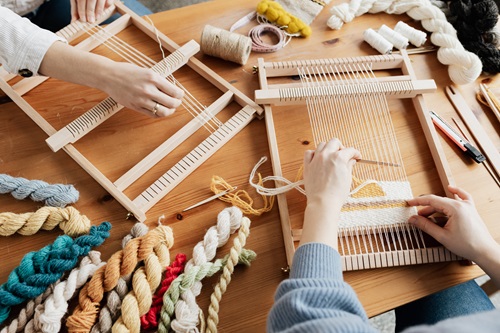History of Fabric Weaving

Fabric weaving has a fascinating history that spans thousands of years, representing a significant milestone in human civilization’s development. Here’s a comprehensive overview of the history of fabric weaving:
Fabric weaving is the process of interlacing two sets of yarns, known as the warp and weft, to create a stable textile structure. This technique has been practiced by various cultures around the world and has played a crucial role in the evolution of clothing, shelter, and artistic expression.
The origins of fabric weaving can be traced back to prehistoric times. Archaeological evidence suggests that early humans used basic weaving techniques to create rudimentary fabrics for clothing and shelter. The first weavings were likely simple and made from natural materials such as plant fibers, animal hair, and reeds.
As civilizations progressed, weaving techniques became more advanced. Ancient civilizations like the Egyptians, Mesopotamians, Greeks, and Romans developed sophisticated looms and weaving methods, contributing to the refinement of textile production. These cultures introduced new fibers, including linen, wool, and silk, and created intricate patterns and designs through the weaving process.
One of the earliest types of looms was the warp-weighted loom, which consisted of a vertical frame with a series of warp threads attached to weights at the bottom. This allowed for tension control and facilitated the interlacing of weft threads, resulting in a tightly woven fabric. Over time, loom technology evolved, and horizontal looms, such as the horizontal treadle loom, became prevalent.
In the Middle Ages, weaving played a pivotal role in the development of trade and commerce. Guilds and weaving communities emerged, fostering specialization and expertise in specific types of fabrics and techniques. With the advent of the Industrial Revolution in the 18th century, weaving underwent a transformative phase. Hand-operated looms were gradually replaced by mechanized looms powered by water, steam, and later, electricity. This mechanization significantly increased textile production, making fabrics more affordable and accessible.
The 19th and 20th centuries witnessed further advancements in weaving technology. The introduction of Jacquard looms, powered by punched cards or later, computer programming, revolutionized pattern weaving. This innovation enabled the production of intricate and complex designs with precision and consistency.
Contemporary fabric weaving combines traditional craftsmanship with modern technology. Computerized looms, such as dobby and rapier looms, have further enhanced weaving efficiency and versatility. These looms can handle a wide range of fibers, from natural to synthetic, and can create various fabric types, including plain weaves, twills, satins, and complex jacquard patterns.
Fabric weaving continues to be a vital industry worldwide, serving multiple sectors such as fashion, home textiles, and industrial applications. Artisans and designers explore weaving as a medium for creative expression, experimenting with innovative materials and techniques. Additionally, sustainability and ethical practices have gained prominence, leading to a resurgence of interest in traditional hand weaving and natural fibers.In conclusion, the history of fabric weaving is a testament to human ingenuity and creativity. From its humble beginnings in ancient civilizations to the sophisticated machinery of the modern era, weaving has evolved as a vital craft and industry. It has shaped cultures, provided livelihoods, and adorned the world with beautiful and functional textiles. The art and science of fabric weaving continue to thrive, embracing tradition while embracing the possibilities of the future.
